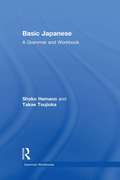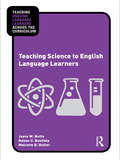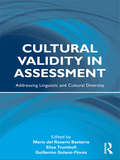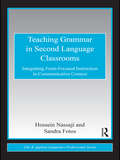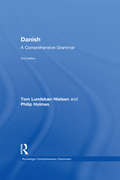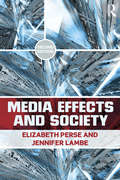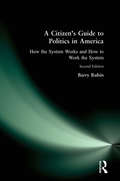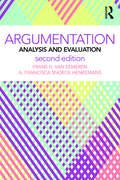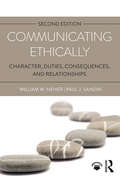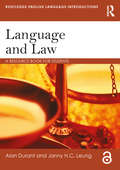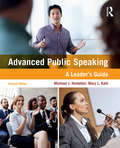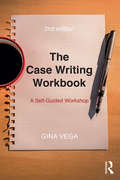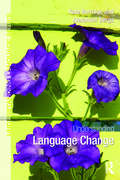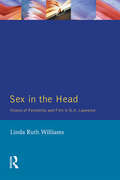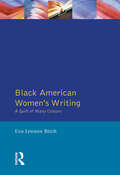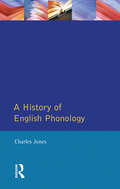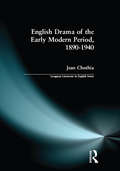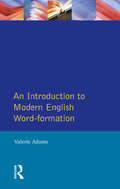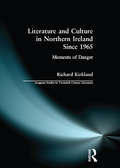- Table View
- List View
Basic Japanese: A Grammar and Workbook
by Shoko Hamano Takae TsujiokaBasic Japanese: A Grammar and Workbook comprises an accessible reference grammar and related exercises in a single volume.This book presents 25 individual grammar points, covering the core material which students would expect to encounter in their first year of learning Japanese. Divided into two parts, the first part outlines fundamental components of Japanese including the writing system, pronunciation, word order, particles and conjugation patterns, while the second part builds on this foundation by introducing basic grammatical patterns organised by the task they achieve. Grammar points are followed by contextualised examples and exercises which allow students to reinforce and consolidate their learning. Key features include: clear, accessible format many useful language examples transliteration of all examples jargon-free explanations of grammar abundant exercises with full answer key subject index. Basic Japanese is suitable both for class use and independent study making it an ideal grammar reference and practice resource for both beginners and students with some knowledge of the language.
Basic Japanese: A Grammar and Workbook
by Shoko Hamano Takae TsujiokaBasic Japanese: A Grammar and Workbook comprises an accessible reference grammar and related exercises in a single volume.This book presents 25 individual grammar points, covering the core material which students would expect to encounter in their first year of learning Japanese. Divided into two parts, the first part outlines fundamental components of Japanese including the writing system, pronunciation, word order, particles and conjugation patterns, while the second part builds on this foundation by introducing basic grammatical patterns organised by the task they achieve. Grammar points are followed by contextualised examples and exercises which allow students to reinforce and consolidate their learning. Key features include: clear, accessible format many useful language examples transliteration of all examples jargon-free explanations of grammar abundant exercises with full answer key subject index. Basic Japanese is suitable both for class use and independent study making it an ideal grammar reference and practice resource for both beginners and students with some knowledge of the language.
Teaching Science to English Language Learners
by Joyce Nutta Nazan U. Bautista Malcolm B. ButlerBooks in the Teaching English Language Learners (ELLs) across the Curriculum Series are written specifically for pre- and in- service teachers who may not have been trained in ELL techniques, but still find themselves facing the realities and challenges of today's diverse classrooms and learners. Each book provides simple and straightforward advice on how to teach ELLs through a given subject area, and how to teach content to ELLs who are at different levels of English language proficiency than the rest of their class. Authored by both language and content area specialists, each volume arms readers with practical, teacher-friendly strategies, and subject-specific techniques. Teaching Science to English Language Learners offers science teachers and teacher educators a straightforward approach for engaging ELLs learning science, offering examples of easy ways to adapt existing lesson plans to be more inclusive. The practical, teacher-friendly strategies and techniques included here are proven effective with ELLs, and many are also effective with all students. The book provides context-specific strategies for the full range of the secondary sciences curriculum, including physical science, life science, earth and space science, science as inquiry, and history and nature of science and more. A fully annotated list of web and print resources completes the book, making this a one volume reference to help science teachers meet the challenges of including all learners in effective instruction. Special features: practical examples of science exercises make applying theory to practice simple when teaching science to ELLs an overview of the National Science Education Standards offers useful guidelines for effective instructional and assessment practices for ELLs in secondary grades graphs, tables, and illustrations provide additional access points to the text in clear, meaningful ways.
Teaching Science to English Language Learners
by Joyce Nutta Nazan U. Bautista Malcolm B. ButlerBooks in the Teaching English Language Learners (ELLs) across the Curriculum Series are written specifically for pre- and in- service teachers who may not have been trained in ELL techniques, but still find themselves facing the realities and challenges of today's diverse classrooms and learners. Each book provides simple and straightforward advice on how to teach ELLs through a given subject area, and how to teach content to ELLs who are at different levels of English language proficiency than the rest of their class. Authored by both language and content area specialists, each volume arms readers with practical, teacher-friendly strategies, and subject-specific techniques. Teaching Science to English Language Learners offers science teachers and teacher educators a straightforward approach for engaging ELLs learning science, offering examples of easy ways to adapt existing lesson plans to be more inclusive. The practical, teacher-friendly strategies and techniques included here are proven effective with ELLs, and many are also effective with all students. The book provides context-specific strategies for the full range of the secondary sciences curriculum, including physical science, life science, earth and space science, science as inquiry, and history and nature of science and more. A fully annotated list of web and print resources completes the book, making this a one volume reference to help science teachers meet the challenges of including all learners in effective instruction. Special features: practical examples of science exercises make applying theory to practice simple when teaching science to ELLs an overview of the National Science Education Standards offers useful guidelines for effective instructional and assessment practices for ELLs in secondary grades graphs, tables, and illustrations provide additional access points to the text in clear, meaningful ways.
Cultural Validity in Assessment: Addressing Linguistic and Cultural Diversity
by María Del Basterra Elise Trumbull Guillermo Solano-FloresWhat is assessment and how is it a cultural practice? How does failure to account for linguistic and cultural variation among students jeopardize assessment validity? What is required to achieve cultural validity in assessment? This resource for practicing and prospective teachers – as well as others concerned with fair and valid assessment – provides a thorough grounding in relevant theory, research, and practice. The book lays out criteria for culturally valid assessment and recommends specific strategies that teachers can use to design and implement culturally valid classroom assessments. Assessment plays a powerful role in the process of education in the US and has a disproportionately negative impact on students who do not come from mainstream, middle-class backgrounds. Given the significance of testing in education today, cultural validity in assessment is an urgent issue facing educators. This book is essential reading for addressing this important, relevant topic.
Cultural Validity in Assessment: Addressing Linguistic and Cultural Diversity
by María Del Basterra Elise Trumbull Guillermo Solano-FloresWhat is assessment and how is it a cultural practice? How does failure to account for linguistic and cultural variation among students jeopardize assessment validity? What is required to achieve cultural validity in assessment? This resource for practicing and prospective teachers – as well as others concerned with fair and valid assessment – provides a thorough grounding in relevant theory, research, and practice. The book lays out criteria for culturally valid assessment and recommends specific strategies that teachers can use to design and implement culturally valid classroom assessments. Assessment plays a powerful role in the process of education in the US and has a disproportionately negative impact on students who do not come from mainstream, middle-class backgrounds. Given the significance of testing in education today, cultural validity in assessment is an urgent issue facing educators. This book is essential reading for addressing this important, relevant topic.
Teaching Grammar in Second Language Classrooms: Integrating Form-Focused Instruction in Communicative Context
by Hossein Nassaji Sandra S. FotosRecent SLA research recognizes the necessity of attention to grammar and demonstrates that form-focused instruction is especially effective when it is incorporated into a meaningful communicative context. Designed specifically for second-language teachers, this text identifies and explores the various options for integrating a focus on grammar and a focus on communication in classroom contexts and offers concrete examples of teaching activities for each option. Each chapter includes a description of the option, its theoretical and empirical background, examples of activities illustrating in a non-technical manner how it can be implemented in the classroom, questions for reflection, and a list of useful resources that teachers can consult for further information.
Teaching Grammar in Second Language Classrooms: Integrating Form-Focused Instruction in Communicative Context
by Hossein Nassaji Sandra S. FotosRecent SLA research recognizes the necessity of attention to grammar and demonstrates that form-focused instruction is especially effective when it is incorporated into a meaningful communicative context. Designed specifically for second-language teachers, this text identifies and explores the various options for integrating a focus on grammar and a focus on communication in classroom contexts and offers concrete examples of teaching activities for each option. Each chapter includes a description of the option, its theoretical and empirical background, examples of activities illustrating in a non-technical manner how it can be implemented in the classroom, questions for reflection, and a list of useful resources that teachers can consult for further information.
Danish: A Comprehensive Grammar (Routledge Comprehensive Grammars)
by Tom Lundskaer-Nielsen Philip HolmesDanish: A Comprehensive Grammar presents a fresh and accessible description of the language, concentrating on the real patterns of use in modern Danish. The volume is organized to promote a thorough understanding of Danish grammar. It offers a stimulating analysis of the complexities of the language, and provides full and clear explanations. This edition has been fully updated to reflect changes in grammar, cultural changes and the impact of modern technology. All sections have been systematically revised, and a new section on phrases and an up-to-the-moment account of the use of the comma have been added. The examples and grammar explanations have been improved throughout. Features include: a wealth of examples from present-day Danish particular attention to areas of confusion and difficulty Danish-English parallels highlighted throughout the book an extensive index and clear paragraph numbering for easy navigation cross-references in all parts of the book. Danish: A Comprehensive Grammar is the most comprehensive and detailed Danish grammar available in English and is an essential reference source for the learner and user of Danish at all levels. It is ideal for use in schools, colleges, universities and adult classes of all types.
Media Effects and Society (Routledge Communication Series)
by Elizabeth M. Perse Jennifer LambeGrounded in theoretical principle, Media Effects and Society help students make the connection between mass media and the impact it has on society as a whole. The text also explores how the relationship individuals have with media is created, therefore helping them alleviate its harmful effects and enhance the positive ones. The range of media effects addressed herein includes news diffusion, learning from the mass media, socialization of children and adolescents, influences on public opinion and voting, and violent and sexually explicit media content. The text examines relevant research done in these areas and discusses it in a thorough and accessible manner. It also presents a variety of theoretical approaches to understanding media effects, including psychological and content-based theories. In addition, it demonstrates how theories can guide future research into the effects of newer mass communication technologies. The second edition includes a new chapter on effects of entertainment, as well as text boxes with examples for each chapter, discussion of new technology effects integrated throughout the chapters, expanded pedagogy, and updates to the theory and research in the text. These features enhance the already in-depth analysis Media Effects and Society provides.
A Citizen's Guide to Politics in America: How the System Works and How to Work the System
by Barry RubinThis book is an antidote for civic apathy and disillusionment. It takes the reader step-by-step through the process of successful action for change -- from the germ of an idea to finding allies, getting the word out, and building the critical mass of people, energy, and support to accomplish the desired result.Filled with abundant practical examples and guidelines for success, the book covers all the bases: how to recognize that it's time for action; how to lobby decision makers; how to go to court; how to use information; how to use the internet effectively; how to get media attention; how to influence public opinion; how to mobilize grassroots support; how to form coalitions; how to organize an initiative or referendum; and more.
Argumentation: Analysis and Evaluation (Routledge Communication Series)
by Frans H. van Eemeren A. Francisca HenkemansThis book concentrates on argumentation as it emerges in ordinary discourse, whether the discourse is institutionalized or strictly informal. Crucial concepts from the theory of argumentation are systematically discussed and explained with the help of examples from real-life discourse and texts. The basic principles are explained that are instrumental in the analysis and evaluation of argumentative discourse. Methodical instruments are offered for identifying differences of opinion, analyzing and evaluating argumentation and presenting arguments in oral and written discourse. Attention is also paid to the way in which arguers attempt to be not just reasonable, but effective as well, by maneuvering strategically. In addition, the book provides a great variety of exercises and assignments to improve the student’s skill in presenting argumentation. The authors begin their treatment of argumentation theory at the same juncture where argumentation also starts in practice: The difference of opinion that occasions the evolvement of the argumentation. Each chapter begins with a short summary of the essentials and ends with a number of exercises that students can use to master the material. Argumentation is the first introductory textbook of this kind. It is intended as a general introduction for students who are interested in a proper conduct of argumentative discourse. Suggestions for further reading are made for each topic and several extra assignments are added to the exercises. Special features: • A concise and complete treatment of both the theoretical backgrounds and the practice of argumentation analysis and evaluation. • Crucial concepts from pragmatics (speech act theory, Grice’s cooperative principle) presented in a non-technical way; introducing the theory of verbal communication. • The first textbook treatment of strategic maneuvering as a way of balancing being reasonable with being effective • Exercises and assignments based on real-life texts from a variety of contexts.
Communicating Ethically: Character, Duties, Consequences, and Relationships
by William Neher Paul SandinCommunicating Ethically provides a broad introduction to the ethical nature of communication. Now in its second edition, the text has been revised to further address current issues, such as: evolving social media and digital platforms, growing cultural communication and discussion of diversity, and the ethics of public discourse. This book combines coverage of the major systems of ethical reasoning with applications, including case studies in each chapter, to investigate ethics within many fields in the communication discipline. Incorporating a simple framework for ethical reasoning allows the reader to develop their own understanding of the various criteria for making ethical judgments.
Communicating Ethically: Character, Duties, Consequences, and Relationships
by William Neher Paul SandinCommunicating Ethically provides a broad introduction to the ethical nature of communication. Now in its second edition, the text has been revised to further address current issues, such as: evolving social media and digital platforms, growing cultural communication and discussion of diversity, and the ethics of public discourse. This book combines coverage of the major systems of ethical reasoning with applications, including case studies in each chapter, to investigate ethics within many fields in the communication discipline. Incorporating a simple framework for ethical reasoning allows the reader to develop their own understanding of the various criteria for making ethical judgments.
Language and Law: A resource book for students (Routledge English Language Introductions)
by Alan Durant Janny HC LeungLanguage plays an essential role both in creating law and in governing its implementation. Providing an accessible and comprehensive introduction to this subject, Language and Law: describes the different registers and genres that make up spoken and written legal language and how they develop over time; analyses real-life examples drawn from court cases from different parts of the world, illustrating the varieties of English used in the courtroom by speakers occupying different roles; addresses the challenges presented to our notions of law and regulation by online communication; discusses the complex role of translation in bilingual and multilingual jurisdictions, including Hong Kong and Canada; and provides readings from key scholars in the discipline, including Lawrence Solan, Peter Goodrich, Marianne Constable, David Mellinkoff, and Chris Heffer. With a wide range of activities throughout, this accessible textbook is essential reading for anyone studying language and law or forensic linguistics. Sections A, B, and C of this book are freely available as a downloadable Open Access PDF under a Creative Commons Attribution-Non Commercial-No Derivatives 4.0 license available at http://www.taylorfrancis.com/books/e/9781315436258
Advanced Public Speaking: A Leader's Guide
by Mary L. Kahl Michael J. HostetlerAdvanced Public Speaking: A Leader's Guide is a comprehensive textbook designed to serve as a speech-making reference for upper-level undergraduate students. Now in its second edition, this volume offers brand new classroom-tested chapter assignments, updated examples, and new content on speaking to international and remote audiences. An instructor’s manual and test bank are available for download on the book’s companion website, offering everything from guidance in constructing a syllabus, to lecture suggestions, to classroom activities. This student-engagement focused and flexible text offers students the opportunity to increase their speaking abilities across a variety of more specific and complex contexts.
The Case Writing Workbook: A Self-Guided Workshop
by Gina VegaThis book offers a modular set of chapters that focus specifically on the challenges related to case writing. Exercises, worksheets, and training activities help guide readers sequentially through the entire process of writing both a case and an instructor’s manual (teaching note). Designed as an individualized workshop to assist case authors to structure their writing, this book combines the easy-to-understand, student-focused language of the first edition with new material covering the latest developments and challenges in the world of case writing. These include: ? A section on writing cases in condensed time frames ? A new module on writing short cases in various formats ? A new module on turning research papers into teaching tools ? A section about growing communities of practice in a university ? An expansion of the student case writing module to include a section on case writing for graduate students ? Twelve new worksheets ? A complete index to facilitate use of the book Finishing all the book’s assignments will result in a complete case and instructor’s manual that can be tested in the classroom and submitted to a conference or journal. The Case Writing Workbook is a must for the shelf of any academic or student conducting qualitative research and looking to enhance their skill set.
The Case Writing Workbook: A Self-Guided Workshop
by Gina VegaThis book offers a modular set of chapters that focus specifically on the challenges related to case writing. Exercises, worksheets, and training activities help guide readers sequentially through the entire process of writing both a case and an instructor’s manual (teaching note). Designed as an individualized workshop to assist case authors to structure their writing, this book combines the easy-to-understand, student-focused language of the first edition with new material covering the latest developments and challenges in the world of case writing. These include: ? A section on writing cases in condensed time frames ? A new module on writing short cases in various formats ? A new module on turning research papers into teaching tools ? A section about growing communities of practice in a university ? An expansion of the student case writing module to include a section on case writing for graduate students ? Twelve new worksheets ? A complete index to facilitate use of the book Finishing all the book’s assignments will result in a complete case and instructor’s manual that can be tested in the classroom and submitted to a conference or journal. The Case Writing Workbook is a must for the shelf of any academic or student conducting qualitative research and looking to enhance their skill set.
Understanding Language Change (Understanding Language)
by Kate Burridge Alexander BergsThe Understanding Language series provides approachable, yet authoritative, introductions to all the major topics in linguistics. Ideal for students with little or no prior knowledge of linguistics, each book carefully explains the basics, emphasising understanding of the essential notions rather than arguing for a particular theoretical position.Understanding Language Change offers a complete introduction to historical linguistics and language change. The book takes a step-by-step approach, first by introducing concepts through English examples and building on this with illustrations from other languages. Key features of this introductory text include: up to date and recent case studies at the end of each chapter chapter summaries and exercises that feature a wide range of languages coverage of application of historical linguistics in each chapter glossary of terms This book is essential reading for any students studying Historical Linguistics for the first time.
Sex In The Head: Visions of Femininity and Film in D.H. Lawrence
by Linda R. WilliamsIn Sex in the Head, Linda Ruth Williams uses psychoanalysis and recent feminist film theory to analyze a network of ideas which link looking with sexuality and difference, in the work of a writer who disavowed, yet covertly enjoyed, the pleasures and power of vision. The book is a departure from the long history of feminist readings of Lawrence, in that it discusses his engagement with theories of the gaze and its cultural forms - cinema, photography, painting and the visual dynamics and metaphors of literary texts - as a way of thinking through gender. It shows him arguing, on the one hand, against the evils of cinema and visual sex, while relishing, through the eyes of women, the moving spectacle of those male bodies which populate the pages of his books. It also questions what it is about the work of such an adamant cinephobe which has made it so thoroughly adaptable for film and television.
Black American Women's Writings
by Eva Lennox BirchThis work discusses a range of novels, short stories and essays by black American women writers from the Harlem Renaissance to the present time. It begins with a survey of 19th-century black women's slave narratives, early sentimental novels and autobiographies and then focuses on six writers: Zora Neale Hurston, Paule Marshall, Audre Lorde, Toni Morrison, Alice Walker and Maya Angelou. The text shows how these writers have developed the preoccupations, themes and narrative strategies of their literary ancestors.
A History of English Phonology (Longman Linguistics Library)
by Charles JonesThis is an attempt to view historical phonological change as an ongoing, recurrent process. The author sees like events occurring at all periods, a phenomenon which he considers is disguised by too great a reliance upon certain characteristics of the scholarly tradition. Thus he argues that those innovations arrived at by speakers of the English language many years ago are not in principle unlike those that can be seen to be happening today. Phonological mutations are, on the whole, not to be regarded as unique, novel, once only events. Speakers appear to present to speech sound materials, a limited set of evaluative and decoding perceptions, together with what would seem to be a finite number of innovation producing stratagems in response to their interpretation. It is stressed that this interpretation may itself be a direct product of the kinds of data selected for presentation in traditional handbooks and Jones notes the fact that phonological change is often "messy" and responsive to a highly tuned ability to perceive fine phonetic detail of a type which, by definition, rarely has the opportunity to surface in historical data sources.
English Drama of the Early Modern Period 1890-1940 (Longman Literature In English Series)
by Jean ChothiaThe period 1890-1940 was a particularly rich and influential phase in the development of modern English theatre: the age of Wilde and Shaw and a generation of influential actors and managers from Irving and Terry to Guilgud and Olivier.Jean Chothia's study is in two parts beginning with a portrait of the period, setting the narrative context and considering the dramatic social and cultural changes at work during this time. It then focuses on some of the main themes in the theatre, from Shaw and comedy, to the rise of political and radio drama, providing an interpretative framework for the period. This volume will be of great benefit to students and academics of English literature and drama, as it covers the work of the major dramatists of the period as well as considering the dramatic output of literary figures, such as James, Eliot and Lawrence.
An Introduction to Modern English Word-Formation
by Valerie AdamsA series to meet the need for books on modern English that are both up-to-date and authoritative.For the scholar, the teacher, the student and the general reader, but especially for English-speaking students of language and linguistics in institutions where English is the language of instruction, or advanced specialist students of English in universities where English is taught as a foreign language
Literature and Culture in Northern Ireland Since 1965: Moments of Danger (Longman Studies In Twentieth Century Literature)
by Richard KirklandThis study considers writing within the cultural context of Northern Ireland and discusses how writing creates a sense of community, and the different forms this takes when written from loyalist or republican perspectives. The book takes its major theoretical energy from readings of Antonio Gramsci's concept of hegemony and Walter Benjamin's work on historiography. hese are applied to major writers such as Seamus Heaney, Tom Paulin, Paul Muldoon and Edna Longley and to institutions such as the Ulster Folk and Transport Museum.
